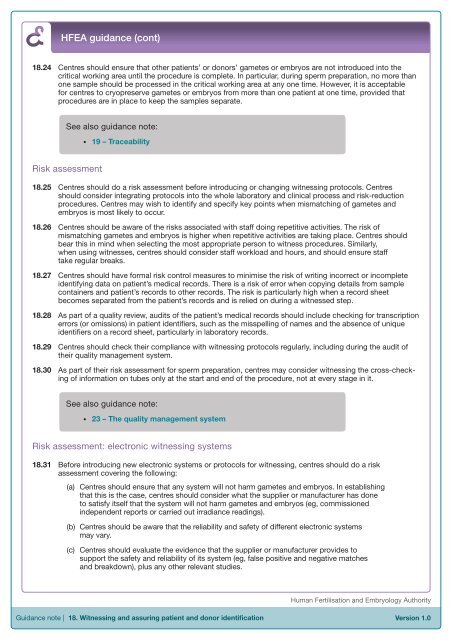Eighth Edition - R.3 - Human Fertilisation & Embryology Authority
Eighth Edition - R.3 - Human Fertilisation & Embryology Authority
Eighth Edition - R.3 - Human Fertilisation & Embryology Authority
You also want an ePaper? Increase the reach of your titles
YUMPU automatically turns print PDFs into web optimized ePapers that Google loves.
HFEA guidance (cont)<br />
18.24 Centres should ensure that other patients’ or donors’ gametes or embryos are not introduced into the<br />
critical working area until the procedure is complete. In particular, during sperm preparation, no more than<br />
one sample should be processed in the critical working area at any one time. However, it is acceptable<br />
for centres to cryopreserve gametes or embryos from more than one patient at one time, provided that<br />
procedures are in place to keep the samples separate.<br />
See also guidance note:<br />
<br />
19 – Traceability<br />
Risk assessment<br />
18.25 Centres should do a risk assessment before introducing or changing witnessing protocols. Centres<br />
should consider integrating protocols into the whole laboratory and clinical process and risk-reduction<br />
procedures. Centres may wish to identify and specify key points when mismatching of gametes and<br />
embryos is most likely to occur.<br />
18.26 Centres should be aware of the risks associated with staff doing repetitive activities. The risk of<br />
mismatching gametes and embryos is higher when repetitive activities are taking place. Centres should<br />
bear this in mind when selecting the most appropriate person to witness procedures. Similarly,<br />
when using witnesses, centres should consider staff workload and hours, and should ensure staff<br />
take regular breaks.<br />
18.27 Centres should have formal risk control measures to minimise the risk of writing incorrect or incomplete<br />
identifying data on patient’s medical records. There is a risk of error when copying details from sample<br />
containers and patient’s records to other records. The risk is particularly high when a record sheet<br />
becomes separated from the patient’s records and is relied on during a witnessed step.<br />
18.28 As part of a quality review, audits of the patient’s medical records should include checking for transcription<br />
errors (or omissions) in patient identifiers, such as the misspelling of names and the absence of unique<br />
identifiers on a record sheet, particularly in laboratory records.<br />
18.29 Centres should check their compliance with witnessing protocols regularly, including during the audit of<br />
their quality management system.<br />
18.30 As part of their risk assessment for sperm preparation, centres may consider witnessing the cross-checking<br />
of information on tubes only at the start and end of the procedure, not at every stage in it.<br />
See also guidance note:<br />
<br />
23 – The quality management system<br />
Risk assessment: electronic witnessing systems<br />
18.31 Before introducing new electronic systems or protocols for witnessing, centres should do a risk<br />
assessment covering the following:<br />
(a) Centres should ensure that any system will not harm gametes and embryos. In establishing<br />
that this is the case, centres should consider what the supplier or manufacturer has done<br />
to satisfy itself that the system will not harm gametes and embryos (eg, commissioned<br />
independent reports or carried out irradiance readings).<br />
(b)<br />
(c)<br />
Centres should be aware that the reliability and safety of different electronic systems<br />
may vary.<br />
Centres should evaluate the evidence that the supplier or manufacturer provides to<br />
support the safety and reliability of its system (eg, false positive and negative matches<br />
and breakdown), plus any other relevant studies.<br />
<strong>Human</strong> <strong>Fertilisation</strong> and <strong>Embryology</strong> <strong>Authority</strong><br />
Guidance note | 18. Witnessing and assuring patient and donor identification<br />
Version 1.0

















